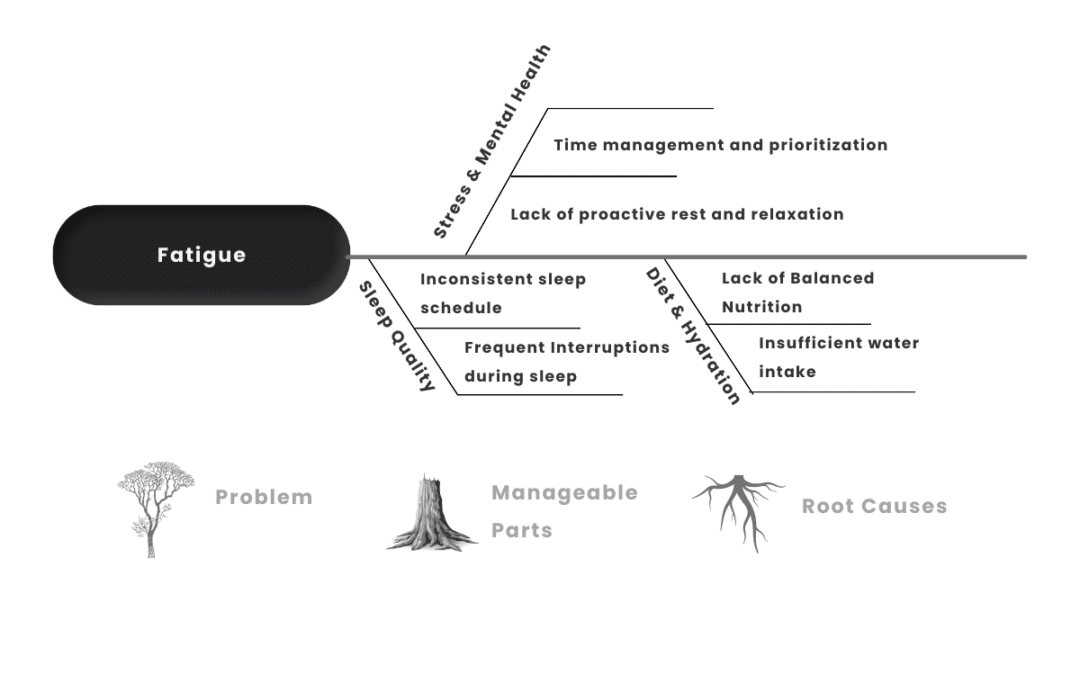Reading Time: 5 minutes
Key Points
- Ishikawa diagrams help identify the root causes of problems.
- It helps deconstruct intricate problems into manageable parts, paving the way for clear, logical thinking.
- You can apply this method individually or in a group setting.
The Ishikawa Diagram
The Ishikawa diagram, sometimes known as the fishbone or cause-and-effect diagram, is a pivotal tool in problem-solving and was innovated by Professor Kaoru Ishikawa. It’s particularly useful for deconstructing intricate problems into manageable parts, paving the way for clear, logical thinking.
Step-by-Step Guide to Using Ishikawa Diagrams:
The Ishikawa Diagram mental model can be broken down into four sequential steps:
- Define the Problem: Start by pinpointing the problem and sketching a line to its left or right. This line will host the contributing factors identified in the next step.
- Identify Contributing Factors: Outline potential contributing factors or categories related to the problem and position them along the main line. You can use generic categories like People, Equipment, Methods, Measurement, Material, and Environment, or create your own.
- Determine Possible Root Causes: For each factor, ask, “Why is this happening?” and jot down every response. Utilize the “Five whys” method to dig deeper into each cause. Understand that a problem may have multiple root causes.
- Analyze the Diagram: Review all the identified root causes and ponder over them. This diagram aids in organizing your thoughts and defining your next moves, which could include gathering more data or immediately addressing the most apparent root cause.
Create Your Ishikawa Journey: Navigating Relatable Scenarios
Scenario 1:
Imagine you’re grappling with a recurring problem we all can relate to: “Constantly Feeling Tired.”
Define Your Problem:
“Constant Fatigue”
Identifying the Contributing Stars:
- Sleep Quality
- Diet and Hydration
- Stress and Mental Health
Seek the Hidden Roots:
- Sleep Quality
- Inconsistent sleep schedule
- Frequent interruptions during sleep
- Diet and Hydration
- Lack of balanced nutrition
- Insufficient water intake
- Stress and Mental Health
- High stress levels leading to burnout
- Lack of proactive relaxation and downtime
Scenario 2:
Let’s delve into a universal struggle: “Lack of Focus.” This issue is especially present nowadays, whether you’re a student, a professional, or simply trying to read a book!
Define Your Problem:
“Persistent Lack of Focus”
Identifying the Contributing Branches:
- Environmental Distractions
- Digital Distractions
- Physical Condition
- Mental and Emotional State
- Task Characteristics
Seek the Hidden Roots:
- Environmental Distractions
- Noise and chatter
- Unorganized workspace
- Digital Distractions
- Notifications
- Open tabs
- Physical Condition
- Lack of sleep
- Hunger or dehydration
- Mental and Emotional State
- Stress or anxiety
- Lack of interest or motivation
- Task Characteristics
- Lack of clarity in task
- Monotony or lack of challenge
Your Turn: Create Your Own Ishikawa Diagram
- Grab a Pen and Paper or Use a Digital Tool.
- Define Your Problem: Write it down clearly.
- Identify Contributing Factors: What elements could be playing a part in this?
- Find Possible Root Causes: For each factor, ask, “Why is this happening?”
- Analyze Your Diagram: Weigh each root cause and decide your next steps.
Quick Tip:
Dig deeper at each step, asking “why” until you reach the underlying cause. The more detailed, the clearer your path to solutions!
Reflection Point:
In what areas of your personal life could a deeper understanding of underlying issues lead to more peace and fulfillment? How can examining these issues steer you toward better life choices and happiness?
A Gentle Nudge:
Every struggle has its roots. Discovering them can seem overwhelming, but with the Ishikawa diagram, you navigate, learn, and find clarity, one root at a time!

